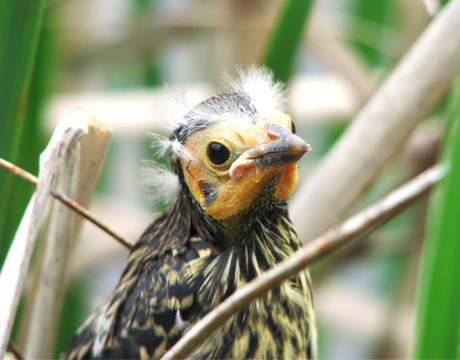 Important Note:
Important Note:
The 1918 Migratory Bird Treaty Act protects all native birds. It is illegal for any person to possess birds, dead or alive, nesting material, eggs, feathers and bones of a bird without the proper permits from the United States Fish & Wildlife Service (USFWS) and the State of Illinois. It is illegal to harm or kill a protected bird species. It is also illegal to remove or destroy nesting material from a nest once an egg has been laid. Contact the USFWS for additional information on the Migratory Bird Treaty Act.
Incompletely Feathered Baby Birds
Partially feathered baby birds are commonly found on the ground during spring and summer. It is often assumed that they have fallen from a nest, but they are more likely “fledglings," a stage of development when birds commonly jump or fall from their nest. It's natural to think they may need your help, but this stage in a bird’s development is part of its "flight training." The adults will continue to feed fledglings on the ground until they are able to fly, but they will be nervous to bring food if they think a predator is nearby.
It’s best to watch fledglings from a distance. If the young bird is not obviously injured it is best to leave it alone and keep cats, dogs and curious children away so the adults can continue to feed it.
Featherless or Downy Baby Birds
Baby birds that are naked or covered with down are considered to be "nestlings." These babies should remain in the nest for the parents to feed them. If a nestling is found out of a nest, it is likely that it has fallen out, was blown out during a windstorm, or was pushed by a sibling.
If you come across a featherless baby bird out of its nest, try locating the nest in nearby trees and shrubs and place the nestling back inside the nest. Nestlings are usually found on the ground directly below their nest. If you cannot locate the nest, you can create a temporary nest with a clean container, such as a margarine dish. Make holes in the bottom to allow for water drainage and line the bowl with paper towels. Tack the homemade nest in the tree as close to the original nest as possible, place the baby bird inside and leave. The parents will usually come back in a short time to feed the nestling.
It's a misconception that if you touch a baby animal, especially a bird, that the mother will abandon the infant for good. This is not the case. Birds in general have a poor sense of smell (except for vultures) and will not abandon the baby because it has been handled. The adult will, however, be bothered by your presence around the babies.
Ducklings and Goslings
Discovering a duck or goose nest is common in Lake County. The best course of action is to leave the nest alone and let nature take its course. If you come across a lone duckling or gosling observe it for a few hours. Waterfowl, such as ducks and geese, do not leave their young alone. Call a wildlife rehabilitator for advice if you find young waterfowl alone for an extended period of time.
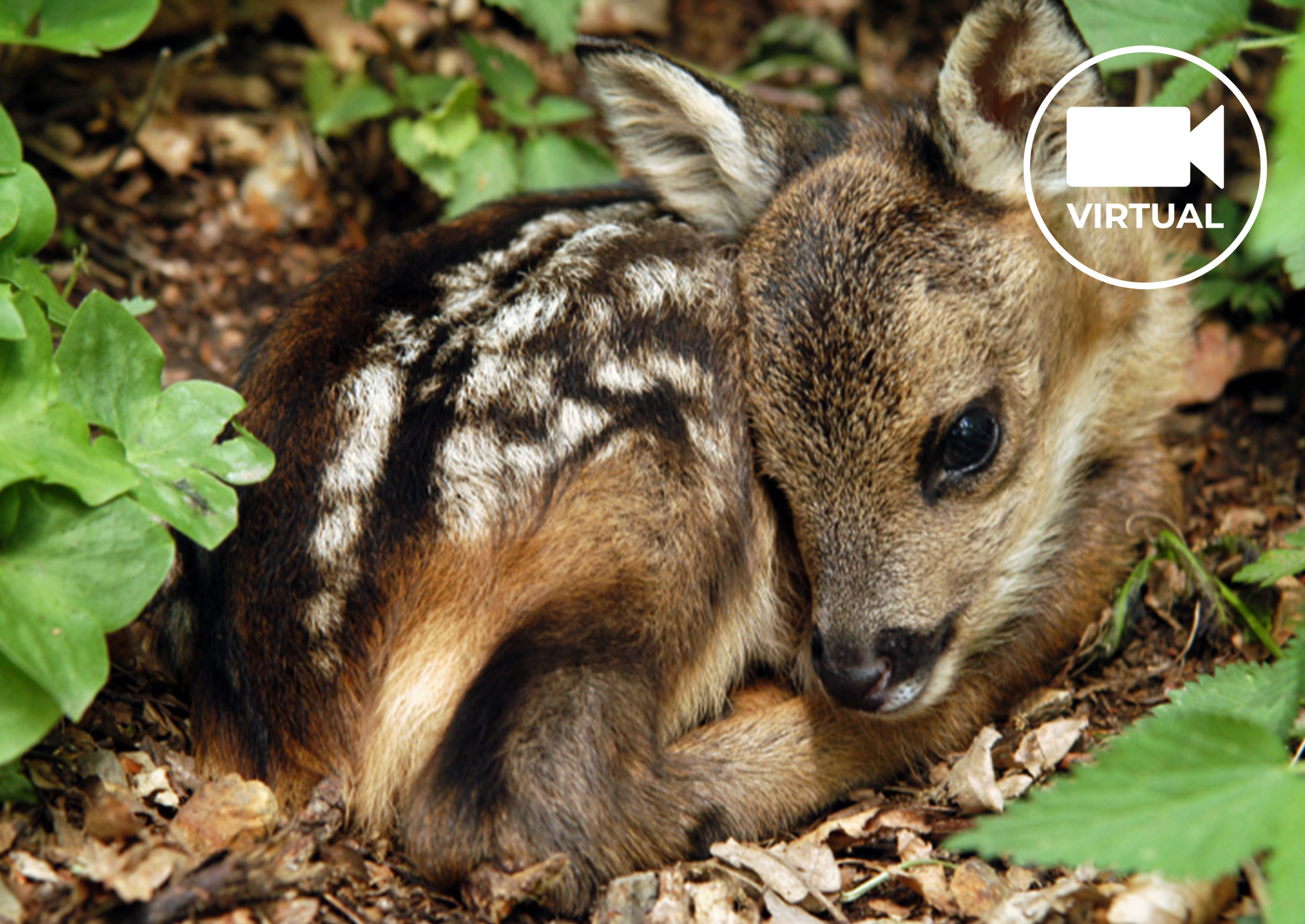 Deer & Raccoons
Deer & Raccoons
Mothers of both species frequently leave their babies alone for several hours at a time. These youngsters are rarely orphans when found alone; the mother is usually nearby. Leave the infants untouched for 24 hours. If they haven't moved and are noticeably weaker, call a wildlife rehabilitator for advice.
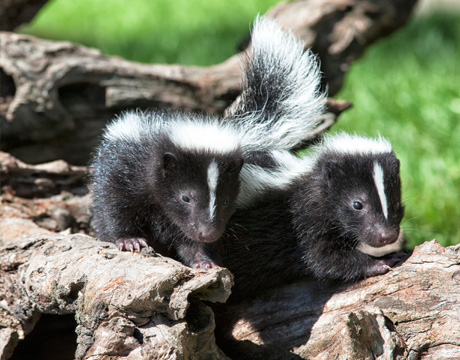 Opossums & Skunks
Opossums & Skunks
While still dependent, baby opossums stay near their mothers. Young skunks, however, often play alone near the den and should not be bothered. Remember that even young skunks are capable of defending themselves with a potent spray.
Older youngsters of these species often accompany their mothers on nocturnal foraging expeditions. If found alone, leave them overnight. If they have not moved by morning, they are possibly lost or orphaned. Call a wildlife rehabilitator for advice.
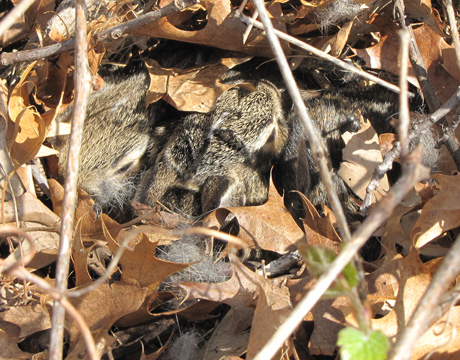 Rabbits
Rabbits
Rabbit nests are shallow holes in the ground, commonly in lawns. The mother usually lines the nest with fur and dry vegetation. People mowing or raking their lawns frequently disturb rabbit nests. It is also common for cats and dogs to find a nest and kill or injure the baby rabbits.
If you find a cottontail nest that has been disturbed, leave the baby rabbits there and cover it with grass clippings. If a baby rabbit is found out of the nest return it to the hole. The mother only comes to feed her young early in the morning and at dusk, so don't expect to see her. If you're worried that mother is not going to return, place a loose string over the nest. If the string has not moved the following morning, it's possible that she has not returned to feed them. Call a wildlife rehabilitator for advice if the babies feel cool and appear hungry.
Young rabbits are independent of their mothers soon after their eyes open and they have fur, although they may only be four or five inches long. They have a high death rate when hand-raised, due largely to the stress of handling by humans.
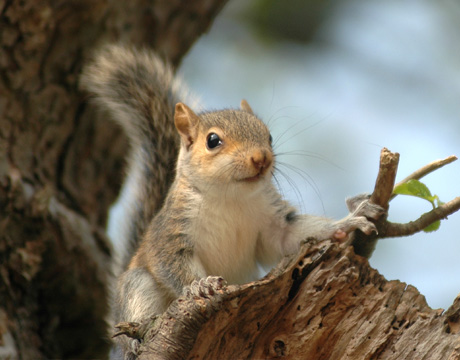 Squirrels
Squirrels
Squirrels make summer homes constructed of leaves, called dreys. These lightweight nests can be destroyed by storms, causing infants to fall. If baby squirrels are found on the ground, place them in a box at the base of a nearby tree. The mother will usually retrieve them when people are not around. Keep dogs, cats and curious children away so the mother will return. Call a wildlife rehabilitator for advice if the mother does not return or if the babies are injured.